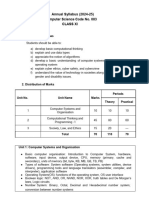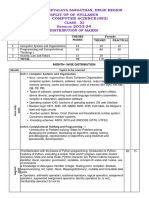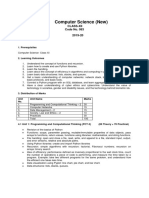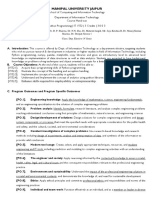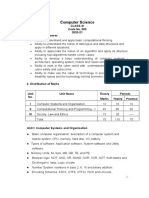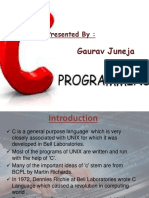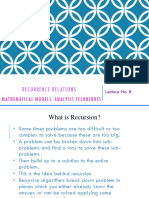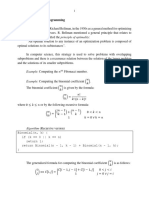Manual 11 - Classes & Objects (OOP) in python
Uploaded by
rahidsaleemcoolManual 11 - Classes & Objects (OOP) in python
Uploaded by
rahidsaleemcoolDepartment of Avionics Engineering
Introduction to Information Technology
Lab Manual 11
Student Name: ___________________________
Registration Number: ___________________________
Section: ___________________________
Deadline: ___________________________
Date of Submission: ___________________________
Institute of Space Technology, Islamabad
Introduction to Information Technology Session: 2024 (AVE-10)
Important Instructions
1. Every student should have lab manual in the lab; otherwise, there will be no evaluation and
attendance.
2. The lab manual should be printed on both sides of the paper. Color printing is not required.
3. Those students who have Laptop must bring it in the lab.
4. Students should read the manual before coming to the lab.
5. Every student will have to submit assignments individually. Assignments after the due date
will not be accepted.
Department of Avionics Engineering,
Institute of Space Technology, Islamabad 2|Page
Introduction to Information Technology Session: 2024 (AVE-10)
Experiment No. 11
Classes & Objects (OOP) in Python
Learning objectives
The main objective is to explore OOP basics in Python. After you’ve completed this manual, you'll be able to:
• Create classes, user-defined behaviors & magic/dunder functions.
• Instantiate objects and their attributes.
Task 0:
Create a python file with title “FirstName_Reg.No_Lab11.py” and define all the classes in this file.
[i.e., This file will have class definitions only]
Create another python file with title “main_Reg.No_Lab11.py” and create all the objects and demonstration
work in this file. [Import the above module in this file as directly available.]
>>from Reg.No_FirstName_Lab11 import *
Task 1:
Create a class named Tesla that has two Instance attributes: color & acceleration and a user defined behavior
named print_data(self). Since the attributes are instance attributes, these must be declared inside
Constructor(__init__(self,.)) as shown.
Instantiate an object from Tesla class and call the behavior print_data(self) and observe the output.
Output: ______________________________________________________________
Department of Avionics Engineering,
Institute of Space Technology, Islamabad 3|Page
Introduction to Information Technology Session: 2024 (AVE-10)
Create __str__(self) magic/dunder method in above class to overload the print() method(Concept of Method
Overloading as discussed in class) as shown:
Note that the __str__ method must have return statement and the string to be returned.
Now instead of calling the print_data() function, print the c1 object directly as print(c1) and observe the
output.
Output: ______________________________________________________________
Task 2:
Create a class named StudentsData that has three instance attributes: name, Reg_No, & age (declare inside
Constructor) and override the default __str__ method to print these attributes directly through print()
command. Instantiate an object from StudentsData class and print it to observe the output.
Write your Code here:
Output:
Department of Avionics Engineering,
Institute of Space Technology, Islamabad 4|Page
Introduction to Information Technology Session: 2024 (AVE-10)
Task 3:
Create a class named Polygon that has two Instance attributes: number_of_sides & side_lengths[] (an array
that will store the side lengths).
Create a user-defined behavior named inputSides(self). Observe & understand the code, recall the concepts
of List comprehension, dictionary etc.
Also, create a user-defined behavior named find_Area(self) as shown below.
Instantiate a triangle object from Polygon class and call the behaviors input_sides() and findArea() and
observe the output.
Output:
Department of Avionics Engineering,
Institute of Space Technology, Islamabad 5|Page
Introduction to Information Technology Session: 2024 (AVE-10)
Similarly, Instantiate a rectangle object from Polygon class and call the behaviors input_sides() and
findArea().
Write your Code here:
Output:
Task4:
List down the names of all the concepts used in this Manual.
Department of Avionics Engineering,
Institute of Space Technology, Islamabad 6|Page
You might also like
- Machine Learning For Absolute Beginners A - Oliver Theobald100% (2)Machine Learning For Absolute Beginners A - Oliver Theobald179 pages
- Principles For Programmers - Andrei Neagoie100% (3)Principles For Programmers - Andrei Neagoie61 pages
- Expert C Programming Peter Van Der Linden PDFNo ratings yetExpert C Programming Peter Van Der Linden PDF2 pages
- Manual 5 - Input, Output Function, Variables & DatatypesNo ratings yetManual 5 - Input, Output Function, Variables & Datatypes11 pages
- Learning Outcomes: Computer Science Class-Xi Code No. 083 2021-22No ratings yetLearning Outcomes: Computer Science Class-Xi Code No. 083 2021-224 pages
- Lab Manual - LP2 - Sem - II - 2022 - 23No ratings yetLab Manual - LP2 - Sem - II - 2022 - 2391 pages
- Computer Science: Basic Computer Organisation: Description of A Computer SystemNo ratings yetComputer Science: Basic Computer Organisation: Description of A Computer System5 pages
- Overview of Computer Science: Phillip BarryNo ratings yetOverview of Computer Science: Phillip Barry238 pages
- Coding-in-Minecraft-Introduction-to-Coding-using-MakeCode-Scope-and-Sequence-013025No ratings yetCoding-in-Minecraft-Introduction-to-Coding-using-MakeCode-Scope-and-Sequence-0130257 pages
- REVISEDComputer Science SR - Sec 2020-21 PDFNo ratings yetREVISEDComputer Science SR - Sec 2020-21 PDF10 pages
- Computer Science (New) : Class-Xii Code No. 083 2019-20No ratings yetComputer Science (New) : Class-Xii Code No. 083 2019-204 pages
- CBSE Class 11 Computer Science Syllabus 2022 23No ratings yetCBSE Class 11 Computer Science Syllabus 2022 234 pages
- Computer Science (New) : Class-Xii Code No. 083 2019-20No ratings yetComputer Science (New) : Class-Xii Code No. 083 2019-203 pages
- Advanced Computer Programming in Python 1st Edition Karim Pichara download100% (3)Advanced Computer Programming in Python 1st Edition Karim Pichara download84 pages
- CS 100 Roadmap To Computing Course Syllabus, Summer 2018No ratings yetCS 100 Roadmap To Computing Course Syllabus, Summer 20183 pages
- Download Complete Advanced Computer Programming in Python 1st Edition Karim Pichara PDF for All Chapters100% (4)Download Complete Advanced Computer Programming in Python 1st Edition Karim Pichara PDF for All Chapters81 pages
- IT1552 Python Programming Course Handout 2020No ratings yetIT1552 Python Programming Course Handout 20206 pages
- Learning Outcomes: Computer Science Class-Xi Code No. 083 2021-22No ratings yetLearning Outcomes: Computer Science Class-Xi Code No. 083 2021-228 pages
- Object Oriented Programming (LAB) Comp (ONPO121A)No ratings yetObject Oriented Programming (LAB) Comp (ONPO121A)28 pages
- Download Complete Advanced Computer Programming in Python 1st Edition Karim Pichara PDF for All Chapters100% (2)Download Complete Advanced Computer Programming in Python 1st Edition Karim Pichara PDF for All Chapters78 pages
- All chapters of Solution Manual for Intro to Python for Computer Science and Data Science: Learning to Program with AI, Big Data and The Cloud By Paul J. Deitel, Harvey M. Deitel, are available for quick PDF download100% (9)All chapters of Solution Manual for Intro to Python for Computer Science and Data Science: Learning to Program with AI, Big Data and The Cloud By Paul J. Deitel, Harvey M. Deitel, are available for quick PDF download32 pages
- Advanced Computer Programming in Python 1st Edition Karim Pichara pdf download100% (1)Advanced Computer Programming in Python 1st Edition Karim Pichara pdf download82 pages
- Python for Everyone 2nd Edition Cay Horstmann instant download100% (1)Python for Everyone 2nd Edition Cay Horstmann instant download74 pages
- REVISED11 - SR - SEC. - Computer Science - 2020-21No ratings yetREVISED11 - SR - SEC. - Computer Science - 2020-215 pages
- Salesforce Certified Platform Developer I CRT-450 Exam PreparationFrom EverandSalesforce Certified Platform Developer I CRT-450 Exam PreparationNo ratings yet
- Sorting Algorithm: 1. Heapsorting Heap Sort Is A Comparison Based Sorting Technique Based On Binary Heap DataNo ratings yetSorting Algorithm: 1. Heapsorting Heap Sort Is A Comparison Based Sorting Technique Based On Binary Heap Data2 pages
- Eecs2070 02 Introduction To SystemverilogNo ratings yetEecs2070 02 Introduction To Systemverilog27 pages
- Recurrence Relations: Mathematical Models, Analysis TechniquesNo ratings yetRecurrence Relations: Mathematical Models, Analysis Techniques38 pages
- CSE 225 Data Structures and Algorithms: Mirza Mohammad Lutfe ElahiNo ratings yetCSE 225 Data Structures and Algorithms: Mirza Mohammad Lutfe Elahi36 pages
- MATLAB Programming for Engineers 6th Edition Stephen J. Chapman downloadNo ratings yetMATLAB Programming for Engineers 6th Edition Stephen J. Chapman download46 pages















